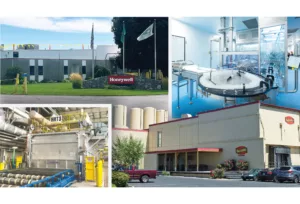Five Takeaways: 2025 Economic Outlook
With Washington Trust Bank Chief Economist Steve Scranton

In early December, the Journal of Business hosted Washington Trust Bank Chief Economist Steve Scranton for its most recent Elevating The Conversation podcast.
The Elevating The Conversation podcast is available on Apple Podcasts, Amazon Music, Spotify, and elsewhere. Search for it on any of those platforms or the Journal's website to hear the entire conversation, but for now, here are five takeaways—edited for space and clarity—from the episode, which runs just over 30 minutes.
1. Short-term interest rates are coming down, but consumers are still feeling the effects of inflation. I question why the Federal Reserve even cut rates to begin with, if they're really saying their mandate is full employment and stable inflation at the 2% level. We have full employment. We don't have inflation close to 2% yet.
So the wording that Chairman Jerome Powell and the Federal Reserve is now using is that they didn't cut rates because they're concerned about the economy, but because they are highly confident inflation will come down to 2%. And the reason they cut rates is to bring it back toward the neutral level.
The Federal Reserve looks at the growth rate of inflation, but the consumer looks at the prices and says, my costs aren't coming down. When you actually break into the inflation pieces, what we see is that the stuff that the consumer has to buy—insurance, medical, car, rent—they're seeing inflation levels through October still well above 3.5% or 4% in some cases. With car insurance, it's up around 14%.
I think that's where the unhappiness has been from the consumer saying, "You keep telling me inflation is under control, and I don't see the evidence of that."
The Federal Reserve controls short-term interest rates, so that means businesses that have a variable-rate loan that prices against a short-term index are seeing their borrowing costs coming down. But there's been a lot of disappointment from people saying, "Well, how come mortgage rates haven't come down?"
The Federal Reserve doesn't directly control long-term rates. Long-term investors are basically saying that they don't see the evidence yet that inflation is under control, and they're really worried that the government just keeps borrowing more and more money and taking on more and more debt. What they have done is put in a bigger inflation premium and risk premiums.
Since mortgage rates are tied to long-term rates, what we've actually seen since the Fed cut rates in September is that short-term rates have dropped by three quarters of a percent, but long-term rates have gone up half a percent. People are just saying we've got a debt problem, and it's time to start looking at it.
For next year, I think you need to plan on mortgage rates between 6% and 7%, unless the economy suddenly falls off the the edge.
2. Consumer spending, wage pressure need to mellow to curb inflation. To curb inflation, the simplistic answer is the consumer needs to stop spending as much as they're spending. Specifically, the consumer is going to have to slow their pace of spending based on borrowing.
I think that's really where the problem has been ever since COVID. First, the consumer got a lot of free money from stimulus checks, but since then, a lot of the spending that they're doing has been with borrowing.
You see credit card balances near record levels. People pay off a lot of those balances at the end of the month, but it's still a case that if you're borrowing, pulling forward spending from the next month. I think we're gonna need to see the consumer being a little more fiscally conservative and not using debt as much.
On the other side, we still have labor shortages. Businesses are starting to invest in technology, but it takes time to be more productive, to produce more with less people because of the continued rise in wages.
We just saw in the recent employment report that average weekly earnings rose 3.7%. That's great for the average worker, because it's above inflation, but that just means they've got more to spend.
The Federal Reserve really wants to see wage pressure coming down. Businesses are being forced to pay higher wages, and they're passing that through to the price of their product.
3. Tariffs could spur more inflation, but let's see how it plays out. I always caution people that what's promised during an election and what's stated before you take office isn't necessarily what's going to happen. We still don't have a united Republican party.
But if we really put in place tariffs the way President-elect Trump has talked about, with tariffs on all imported goods, that raises costs.
Some of the arguments say that'd be great for small business, because they'll get rid of their competition. And I'm saying, well, stop and think, though, a lot of small businesses have to rely on having their products made overseas to compete with the big guys. So if I'm trying to compete with Target or Walmart, if I can have my goods made in Vietnam or in China or somewhere, at least I can compete.
If you've now raised their costs, we may discover we've actually harmed small business more than we helped them. And I've always argued small business is the heartbeat of our economy. Every city has small businesses.
A tariff is just another tax. The mindset right now is, especially small businesses whose margins are far smaller and that don't have the cash reserves of the big business, they've got to pass that through to the consumer.
So, the implication would be, you're going to see higher prices. Unless the consumer just goes on strike and says, I can't afford this and stops buying. That would imply the economy is starting to slow down dramatically. I think that's the real potential.
4. Job numbers are growing, but it isn't broad-based growth. The evidence that I continue to see is that we're going to still be creating jobs. It really comes down to the question of labor and do we have enough labor to create those jobs? That's my biggest concern with the job picture nationally, and Spokane is no different.
Job growth is highly concentrated in a few industries. When I looked at the most recent jobs report, 73% of all jobs created were in three industries: health care, leisure and hospitality, and professional and business services.
Spokane actually lost jobs over the last month, but we created 3,700 jobs over the last year. Of those, 3,600 were in health care. So I just emphasize that, yes, we are clearly growing jobs, but it's not broad, diversified job growth.
We really have to pay attention to that, because that helps explain why you may have surveys of consumers and they're unhappy. They may be in one of those industries that's not seeing growth.
5. Affordability has emerged as a big challenge for the Inland Northwest. A problem that Spokane has, though on a smaller scale than a Boise or a Bend, Oregon, is a lack of affordability for housing. If you're paying $2,000 a month for rent, that's unaffordable.
Any business that comes in and says, "Hey, I'm tired of where we are. I'm being taxed too much, and the Northwest looks like a great place to live." And then they come to visit and and say, "Wow, there's nowhere near enough housing, and rents are going to be sky high for my employees. I think I'll pass."
What we have is this trend nationally where we're seeing the slow movement toward the middle of the country. The coastal economies are way too expensive. Now you've gotten to the point where even Idaho is becoming unaffordable.
People keep moving inward and saying, Omaha, Nebraska, for example, still has affordable housing, and I'll get over the image of Omaha.
I think that's the biggest challenge for the leaders of the Inland Northwest. It's critical to reestablish and maintain the image and the actions that say we are business friendly. We want businesses. We support businesses, and we're actively working to solve the affordability issue.


_c.webp?t=1763626051)
_web.webp?t=1764835652)

